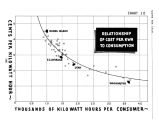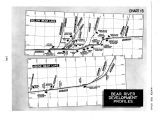| OCR Text |
Show WATER FOR UTAH UTAH'S FERTILIZER INDUSTRIES • ... The Resource Base ... The principal raw material elements required for an integrated fertilizer industry are phosphorus, nitrogen, potassium, sulphur, carbon, calcium and electric power. The resource bases for all of these are available in more than adequate existing and potential quantities in Utah. ( See Map 17 - Fertilizer Industry Pattern - page 70.) Their geographic juxtaposition in Utah, together with its strategic position to supply national and particularly western commercial fertilizer markets, will make possible the expansion' of its existing fertilizer material producing units into an industry of major proportons. However, the prncipal obstacle to the fruition of this potential is the State's present short supplies of low- cost electric power. With the full development of its water resources, resulting in the coproduction of electric power, the rapid development of this entire industry can be assured. ... Phosphorus ... The source of this important chemical and plant food element is phosphate rock and shale. The western phosphate resources, which extend in deposits in a long belt from Montana, through Idaho and Wyoming into Utah, are the Nation's largest potential supply. Sixty per cent of the national reserves are in these deposits, with the remaining 38% in Florida and 2% in Tennessee. In Utah, the phosphoria formations have been estimated at 1,700,000,000 tons, of which at least 68,000,000 tons contain more than 30% P205 ( phosphorus pentoxide, the usual measure of phosphorus concentration). Of these, two areas are considered of greatest importance to the full development of Utah's fertilizer industry. One is north of Vernal in Uintah County, within a few miles of the projected Split Mountain dam site and 30 miles from the Echo Park dam site, both on the Green River. Although this deposit at present is isolated from necessary transportation and power facilities, the proposed construction of these dams will remove those obstacles. The deposit is especially worthy of note because a large portion of it - estimated at over 250,- 000,000 tons- has relatively little overburden, thus making possible inexpensive mining, something which is not the case with the other major deposits in the West. The other important deposit in Utah is east of Randolph in Rich County. Its reserves have been estimated at some 60,- 000,000 tons of high- grade rock. It is located only 12 miles from a transcontinental railroad, and as a consequence, provides for an early opportunity in its usage. The mining of western phosphate rock, strange as it may seem, accounted for only 4.5% of the Nation's total tonnage of mined rock. In Utah, production has beeripiegligible. This anomalous situation is the result of numerous factors primarily stemming from lack of interest and distance from consuming markets. However, with the emergence of new methods of processing and the possibilities of low- cost power supplies, this situation is changing rapidly. ... Nitrogen ... Ammonium sulphate and synthetic ammonia are principal sources of nitrogen for fertilizer manufacture. The by- product coke ovens of Utah produce major quantities of ammonium sulphate, with over 43,000,000 pounds in 1947. There are no synthetic ammonia plants in Utah, although the establishment of one in the vicinity of Salt Lake City has been under discussion from time to time. Ammonia is produced synthetically from hydrogen and nitrogen. The hydrogen results from the interaction of steam upon incandescent coke; the nitrogen is produced by the liquefaction of air. Utah's incomparable supplies of coal and the real need for synthetic ammonia for fertilizer and explosive manufacturing in the West make the establishment of large capacity in Utah somewhat inevitable if low- cost supplies of power and water are provided. [ 69] |















